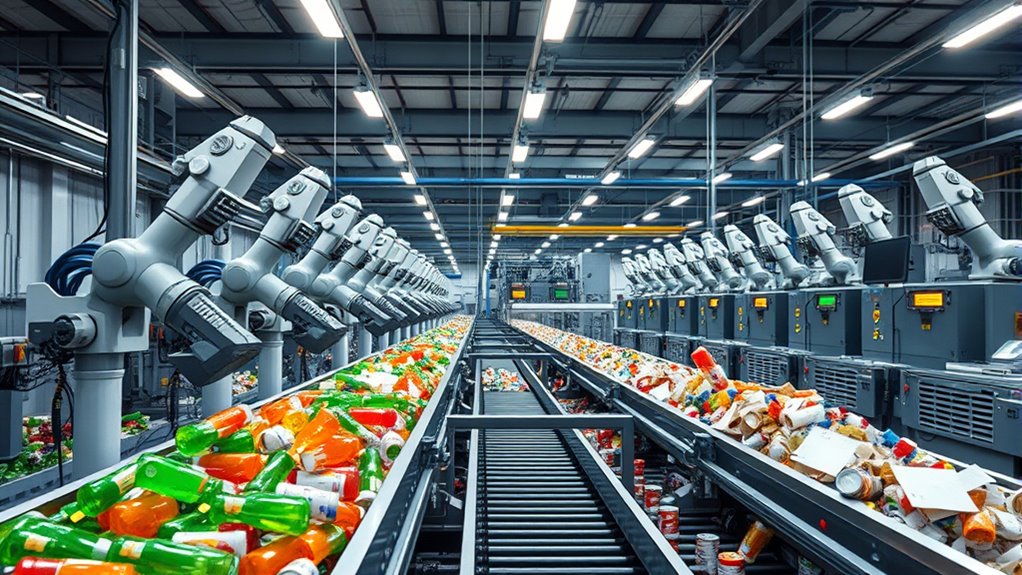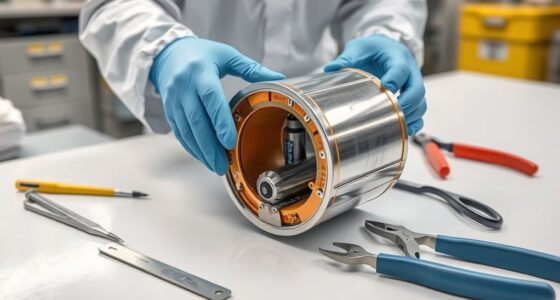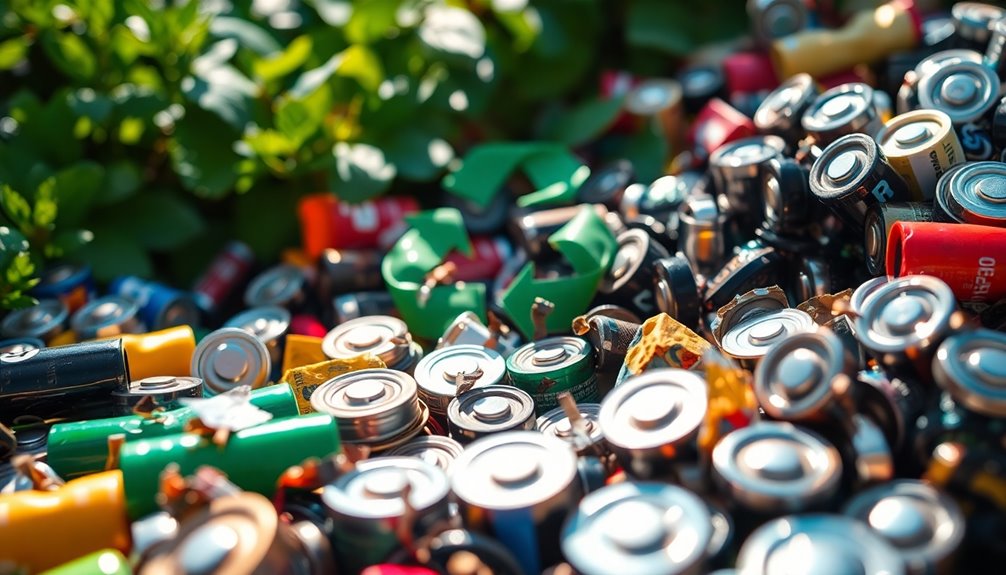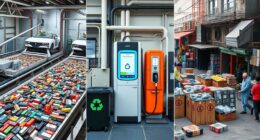Smart sorting and automation in recycling facilities use AI-powered systems and robots to quickly and accurately separate recyclables like plastics, metals, and paper. These technologies analyze items in real-time, reducing manual labor, minimizing contamination, and increasing recycling rates. They also improve safety by handling repetitive tasks and providing valuable data insights for operational optimization. If you want to discover how these innovations are transforming waste management, there’s much more to explore.
Key Takeaways
- AI-powered sorting systems utilize sensors and machine learning to accurately identify and separate recyclables in real-time.
- Robotic automation handles repetitive physical tasks, increasing throughput and reducing workplace injuries.
- Automation enhances waste sorting speed, accuracy, and safety, leading to higher recycling rates.
- Real-time data analytics optimize operations by identifying bottlenecks and improving process efficiency.
- Continued technological advancements support more sustainable, cost-effective, and adaptive recycling facility operations.
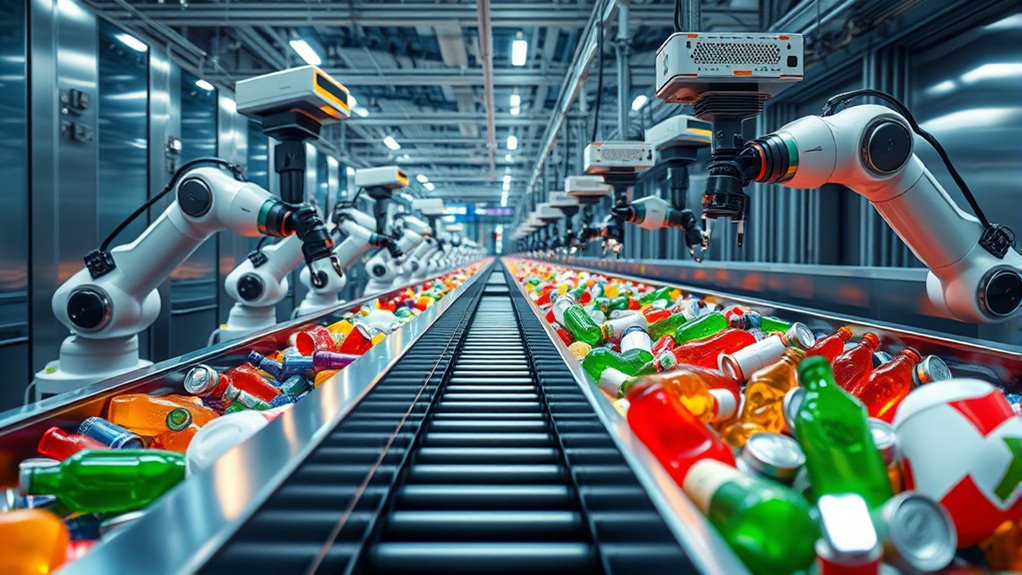
Automation is transforming recycling facilities, making waste sorting faster, more accurate, and safer. By integrating AI-powered sorting systems and robotic process automation, you’re able to streamline operations and reduce human error. These advanced technologies enable your facility to identify and separate materials with precision that was previously impossible, increasing recycling rates and improving overall efficiency. Instead of manually sorting through mountains of waste, you benefit from machines that analyze and categorize materials in real-time, ensuring that each item ends up in the correct bin or processing stream.
AI-powered sorting systems use machine learning algorithms to recognize different types of recyclables, such as plastics, metals, and paper. As waste moves along conveyor belts, sensors and cameras feed data into these intelligent systems, which instantly evaluate each item’s material composition. This allows your facility to quickly sort out contaminants, non-recyclables, and valuable materials, all without human intervention. Because the AI continually learns from new data, its accuracy improves over time, making your sorting process more reliable and consistent. This reduces the chances of recyclable materials ending up in landfills or contaminated streams, which can be costly and environmentally damaging.
AI-driven sorting uses sensors and machine learning to identify recyclables, improving accuracy and reducing waste contamination.
Robotic process automation complements AI-powered sorting by handling repetitive, labor-intensive tasks that used to require many workers. Robots equipped with adaptive grippers and sensors can pick, place, and move materials with incredible speed and precision. This automation not only speeds up throughput but also minimizes workplace injuries and fatigue. With these robots managing the physical sorting tasks, your personnel can focus on overseeing the systems, maintaining equipment, or handling more complex operational decisions. The seamless integration of robotic process automation with AI sorting creates a fully automated workflow that maximizes safety and efficiency.
Moreover, these technologies provide you with valuable data insights. You can track the types and quantities of recyclables processed, identify bottlenecks, and optimize your operations based on real-time analytics. This data-driven approach helps you make informed decisions, improve sorting accuracy, and adapt to changing waste streams. As seen in Hyundai Tuning, integrating advanced systems can significantly enhance performance and sustainability efforts. Overall, AI-powered sorting and robotic process automation are revolutionizing recycling facilities, allowing you to meet environmental goals while reducing costs and labor requirements. As these systems evolve, expect even smarter, more adaptable solutions that will continue to enhance your facility’s performance and sustainability efforts.
Frequently Asked Questions
How Do Smart Sorting Systems Handle Mixed or Contaminated Recyclables?
Smart sorting systems handle mixed or contaminated recyclables by using contaminant detection technologies that identify non-recyclable or harmful materials. They then employ precise material segregation to separate contaminants from valuable recyclables quickly and efficiently. You’ll notice that these systems improve overall purity and quality, reducing waste and contamination issues. This automation allows you to process complex waste streams with accuracy, making recycling more effective and environmentally friendly.
What Are the Initial Costs of Implementing Automation in Recycling Facilities?
Initial costs for automation in recycling facilities typically range from $1 million to $5 million, depending on size and technology complexity. You should consider the capital investment needed for advanced sorting equipment and infrastructure upgrades. Keep in mind, maintenance expenses can amount to 10-15% of the initial costs annually. While the upfront investment seems high, automation can profoundly boost efficiency, reduce labor costs, and improve recycling quality over time.
How Do Automation Systems Adapt to Changing Recycling Regulations?
Automation systems adapt to changing recycling regulations by incorporating flexible software updates and real-time data analysis. You can easily update your system to stay compliant with new policies and environmental standards, ensuring regulatory compliance. Automated sensors and machine learning algorithms continuously monitor policy updates, allowing your facility to respond swiftly. This proactive approach helps avoid penalties, improves efficiency, and keeps your recycling processes aligned with evolving regulatory requirements.
What Training Is Required for Staff to Operate Automated Recycling Equipment?
You need to guarantee staff proficiency by providing extensive training on operation and maintenance of automated recycling equipment. This includes understanding safety protocols to prevent accidents and injuries. Hands-on practice helps staff become confident in handling machinery, troubleshooting issues, and following safety guidelines. Continuous education keeps everyone updated on new features or regulations. Well-trained staff can efficiently operate equipment while maintaining a safe environment, maximizing recycling facility productivity.
How Do Automated Systems Impact Recycling Facility Employment Levels?
Imagine a busy river where automated systems act like swift currents, shifting the flow of jobs. You’ll see some labor displacement as machines handle routine tasks, but new opportunities also emerge. Automation creates jobs in programming, maintenance, and oversight, fueling job creation. While it reshapes employment levels, it ultimately streamlines operations, enabling workers to focus on more skilled roles, balancing the tide of change in recycling facilities.
Conclusion
By embracing smart sorting and automation, you can revolutionize your recycling facility’s efficiency and accuracy. These innovations not only speed up processes but also reduce errors and boost sustainability. Imagine a future where waste is perfectly sorted every time—are you ready to lead that change? With cutting-edge technology at your fingertips, you have the power to make recycling smarter, faster, and more effective than ever before. Why wait to transform your facility today?

